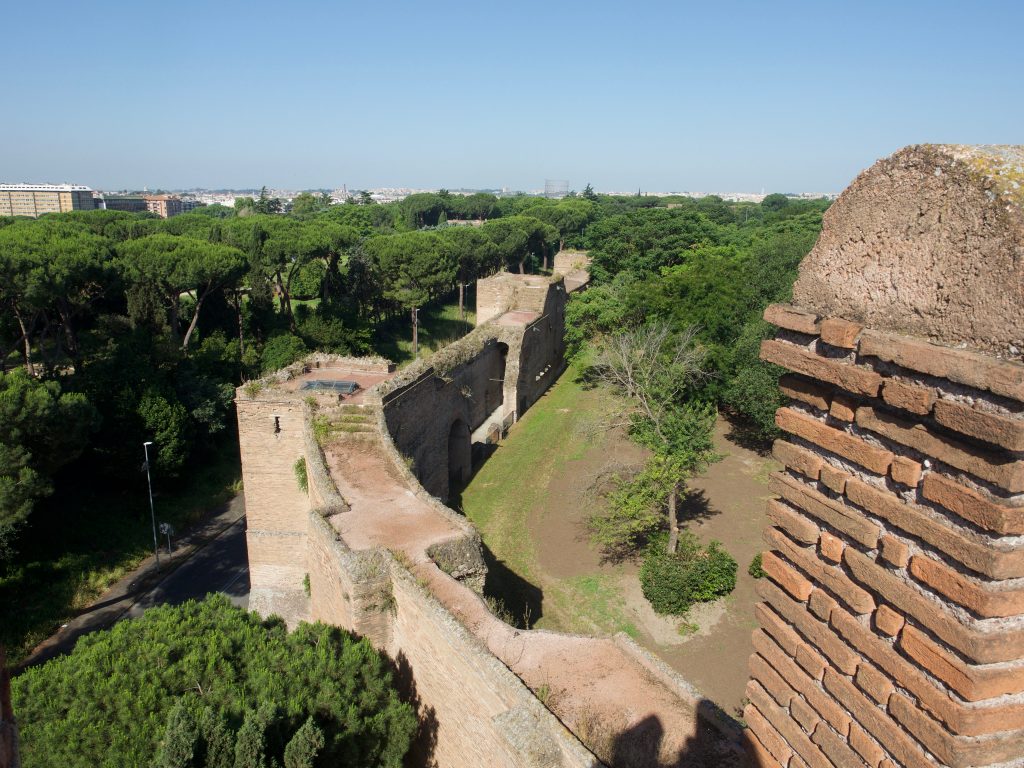
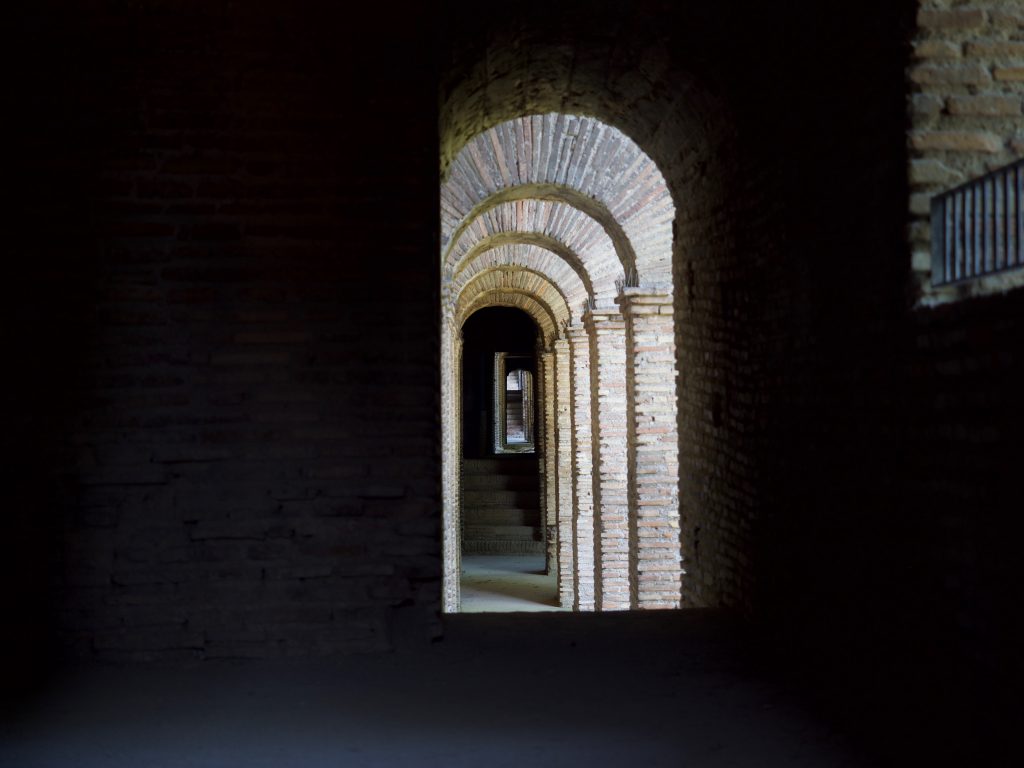
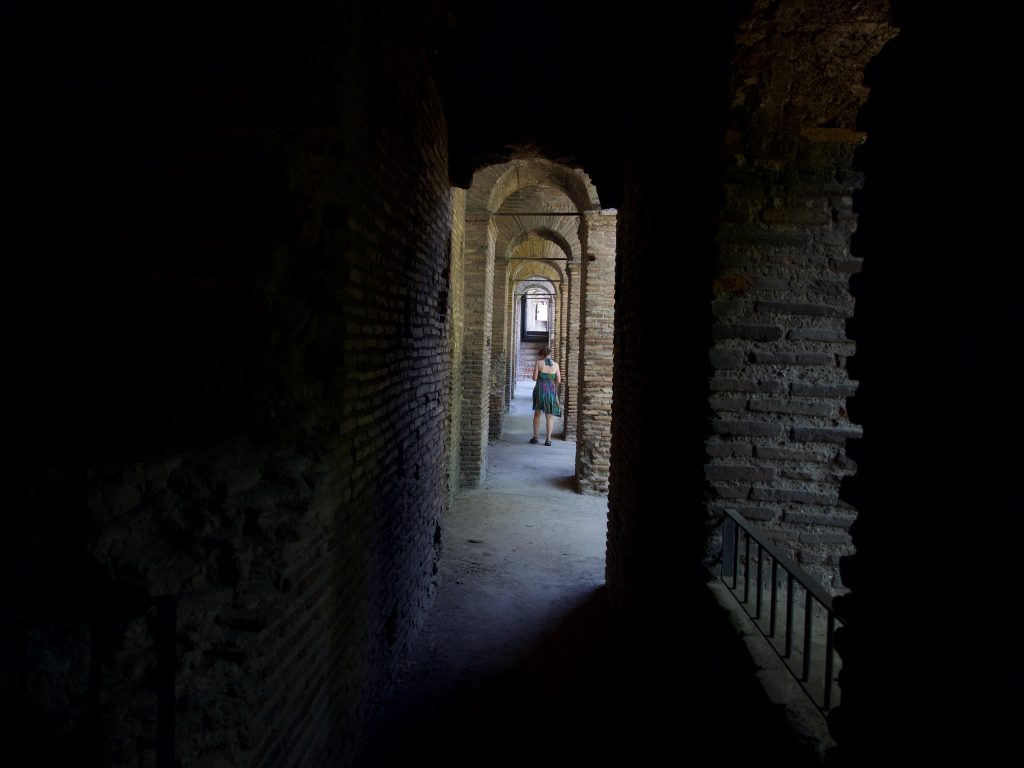
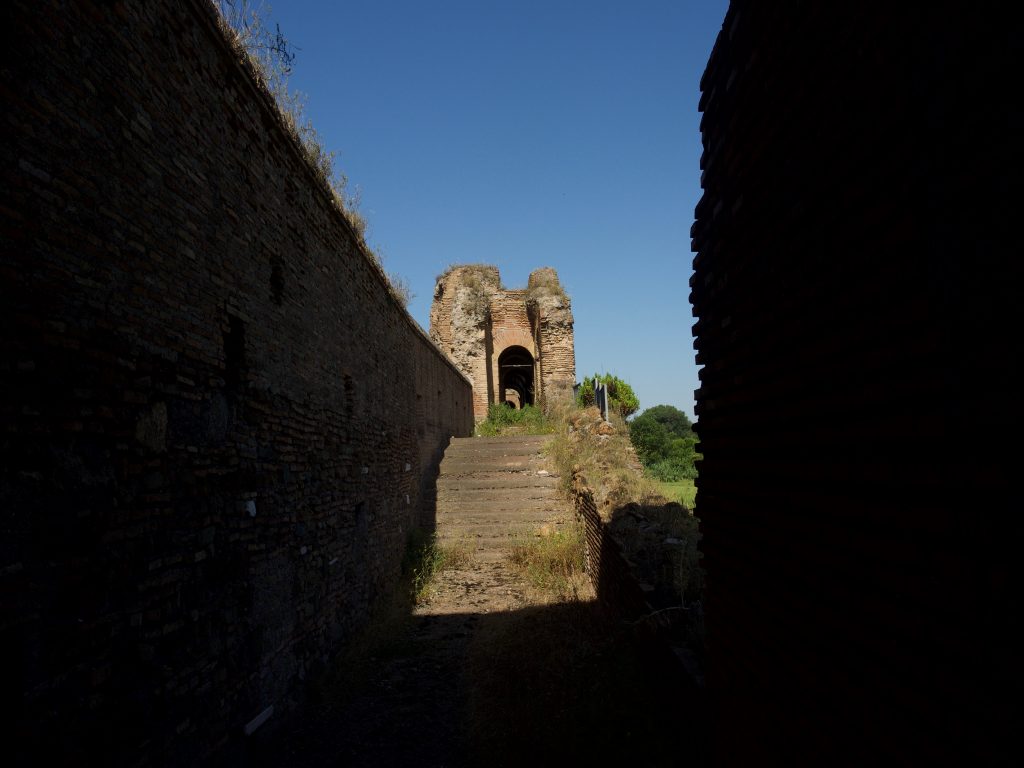
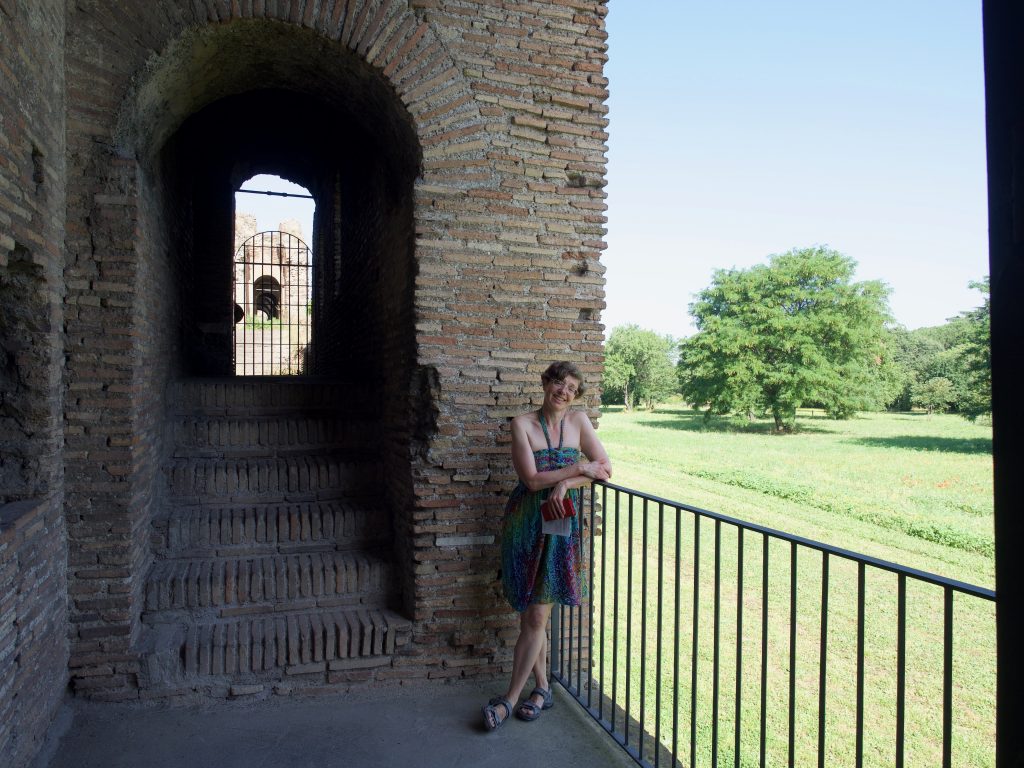
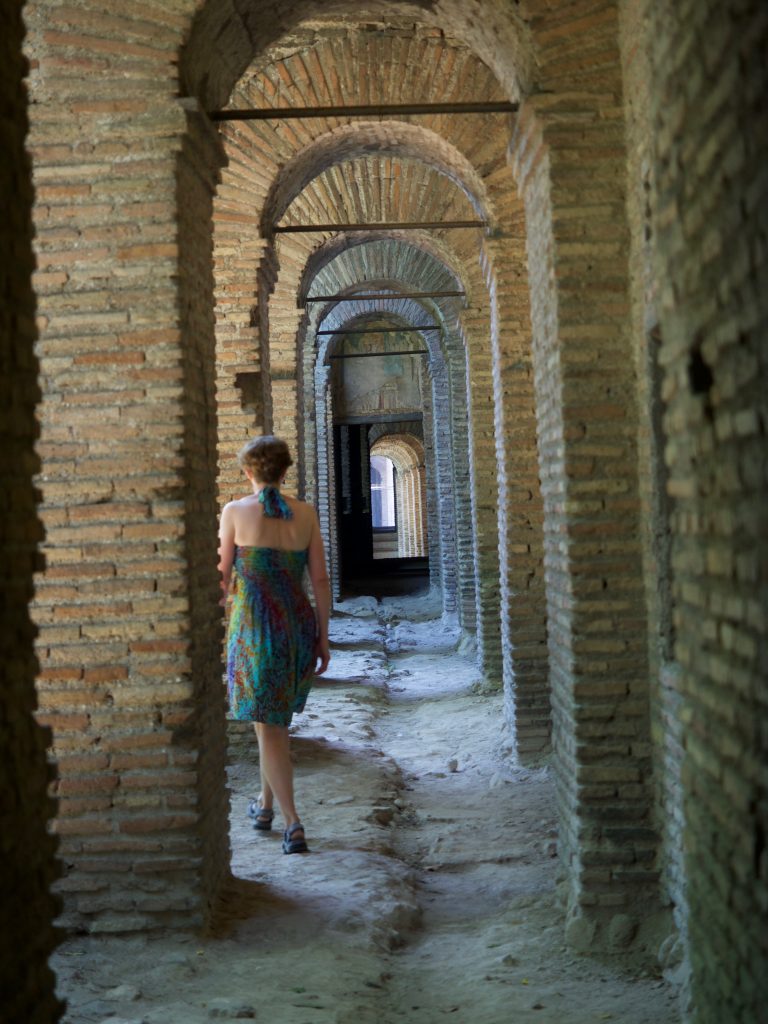
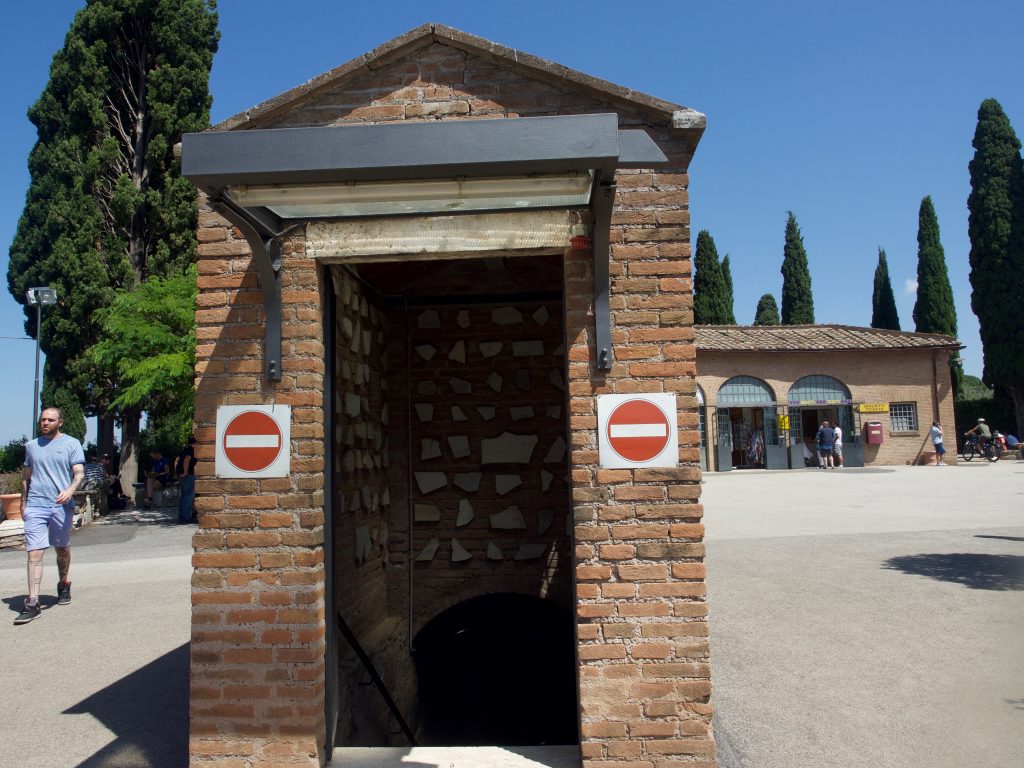
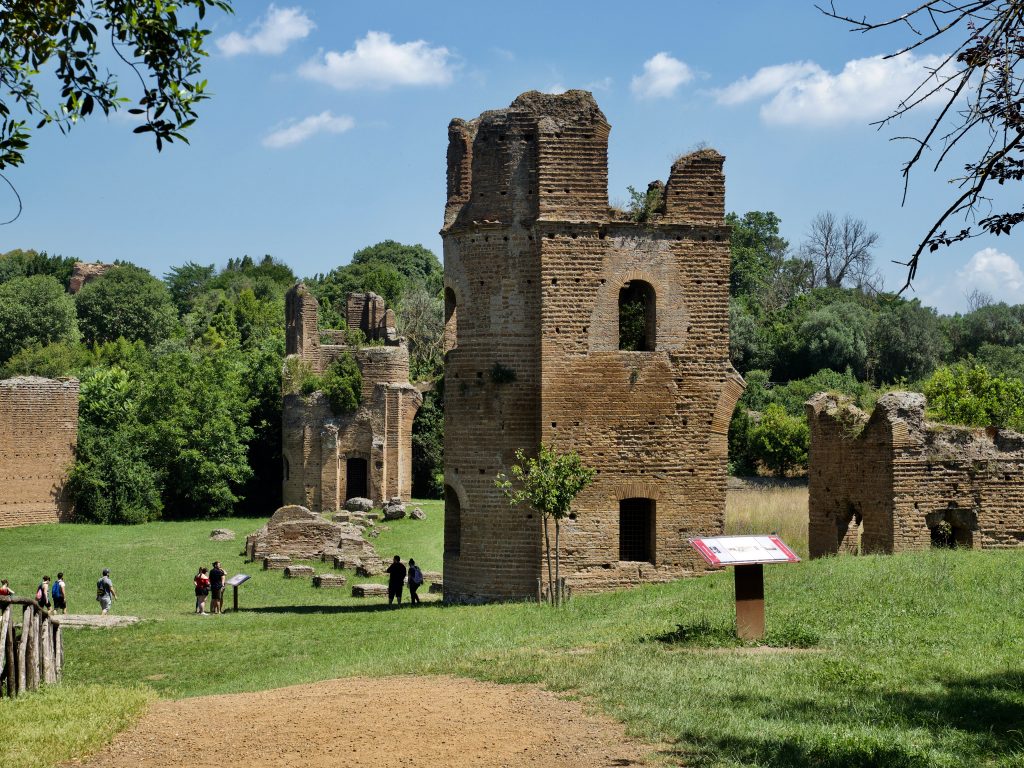
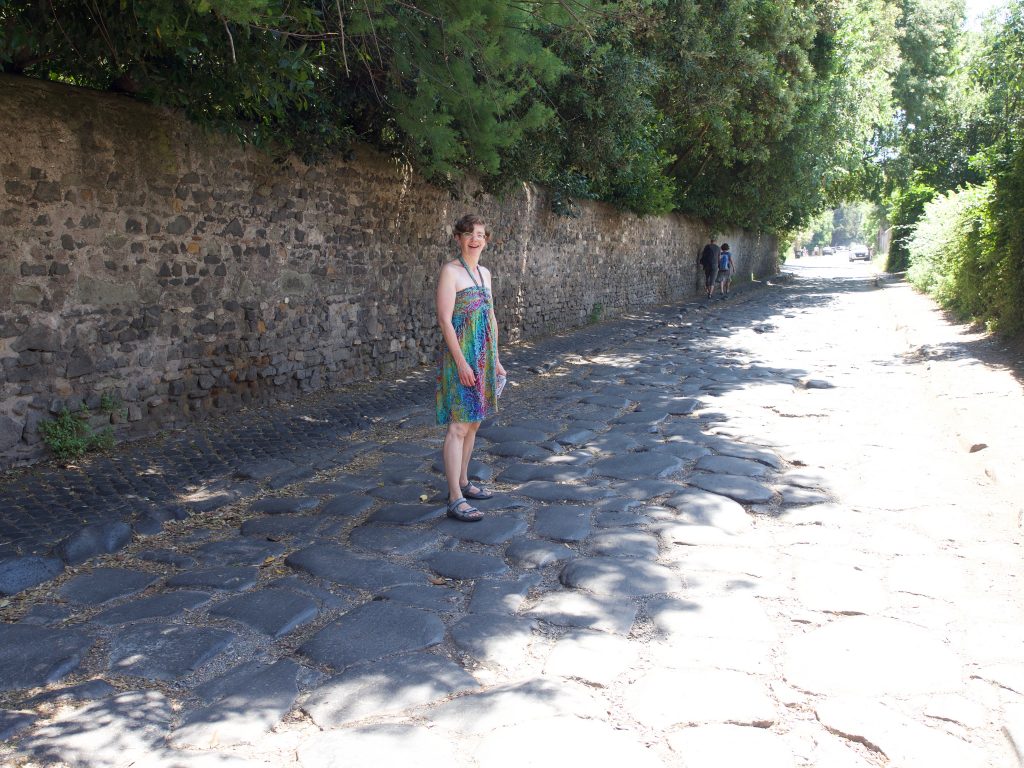
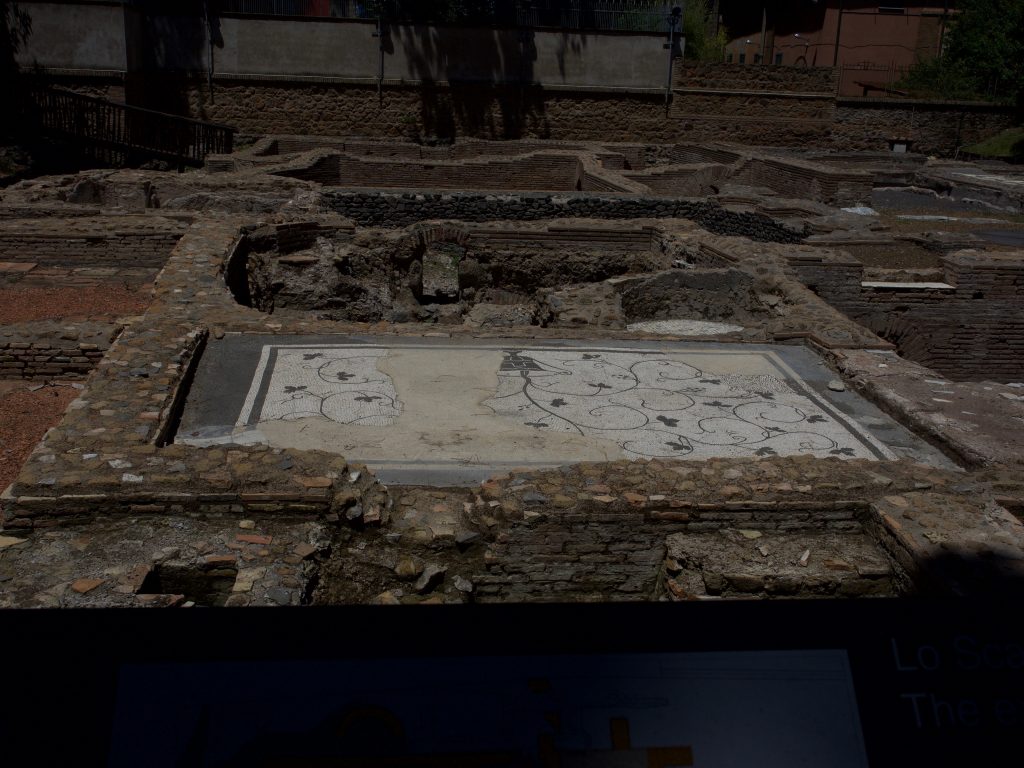
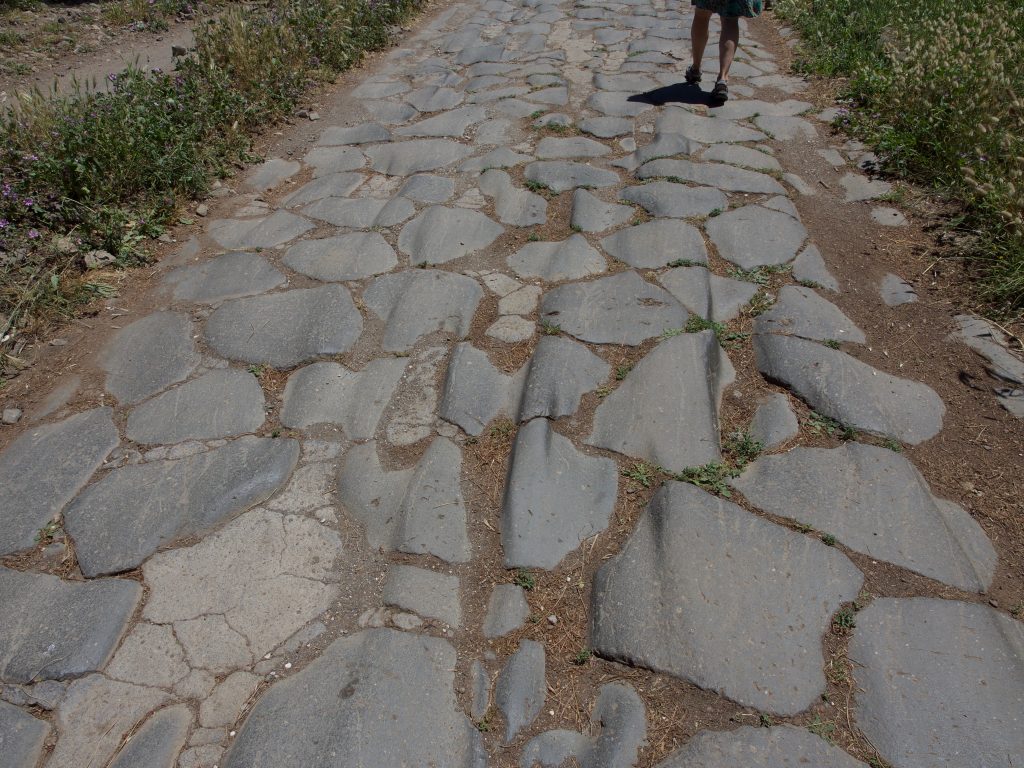
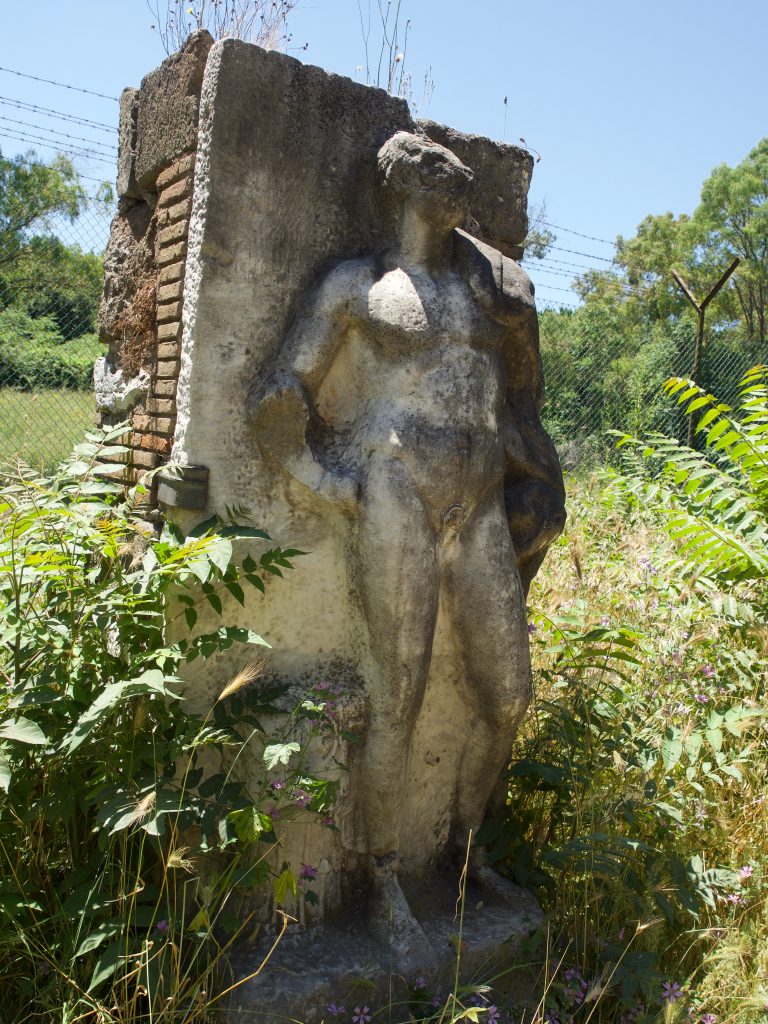
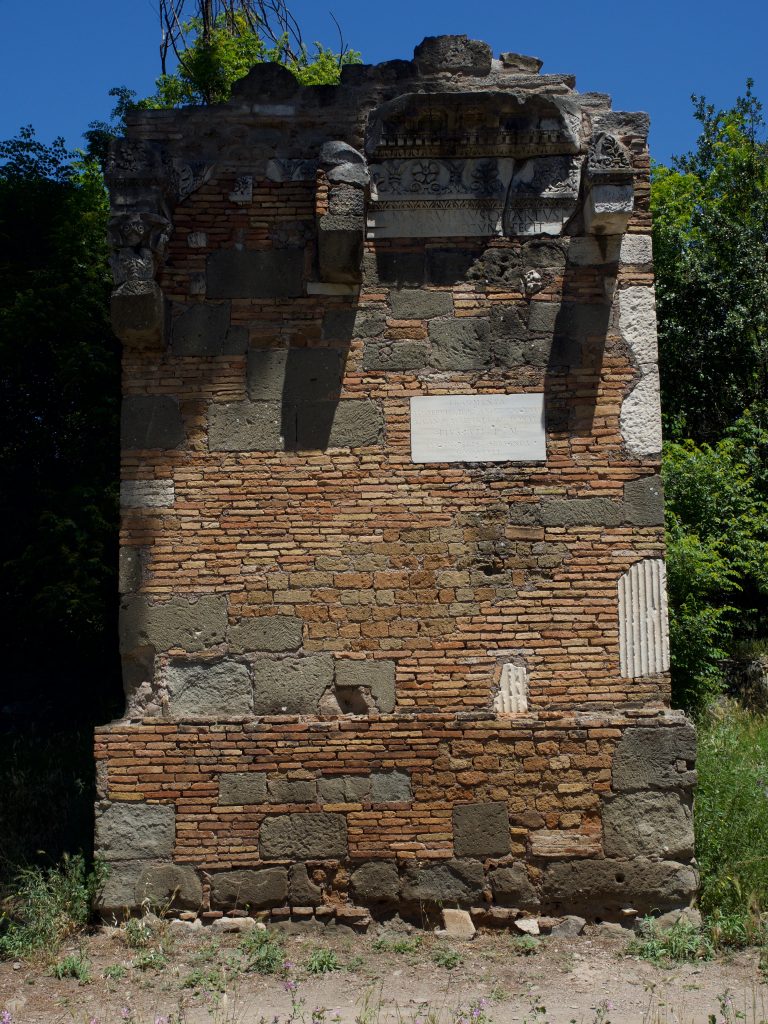
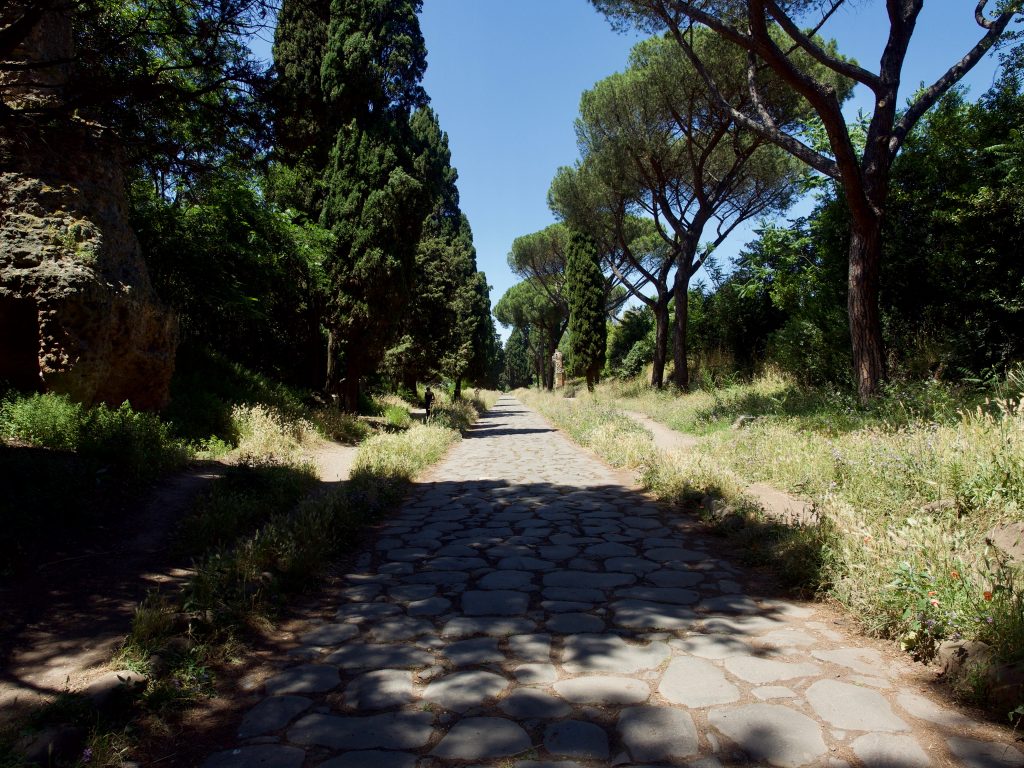
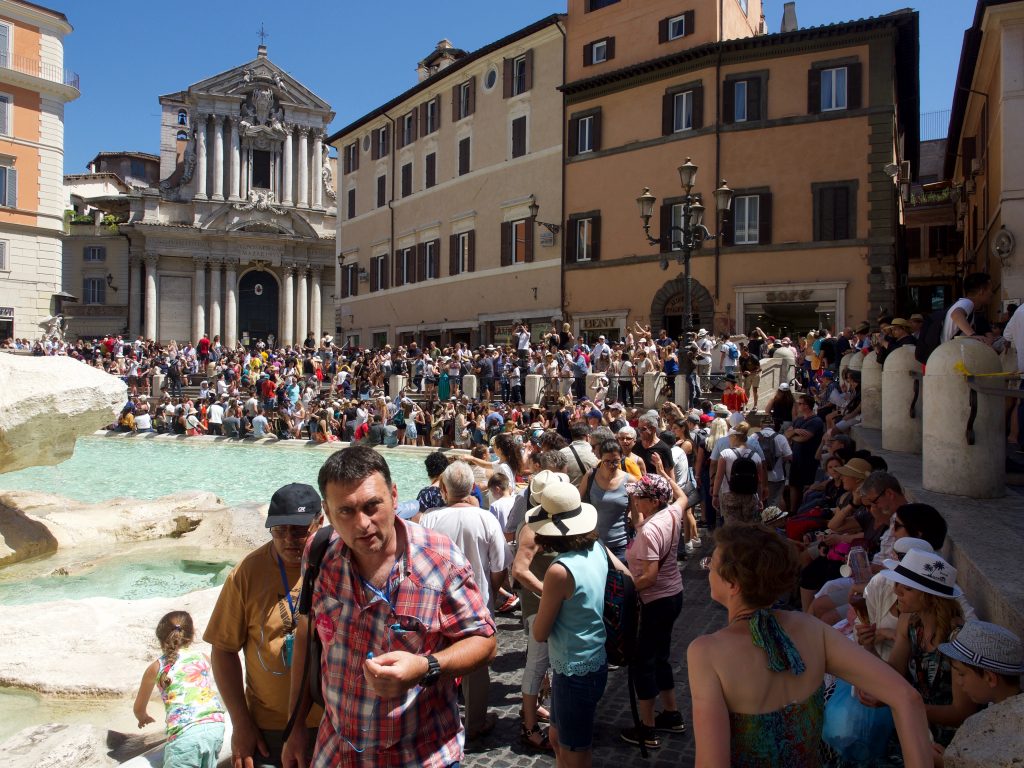
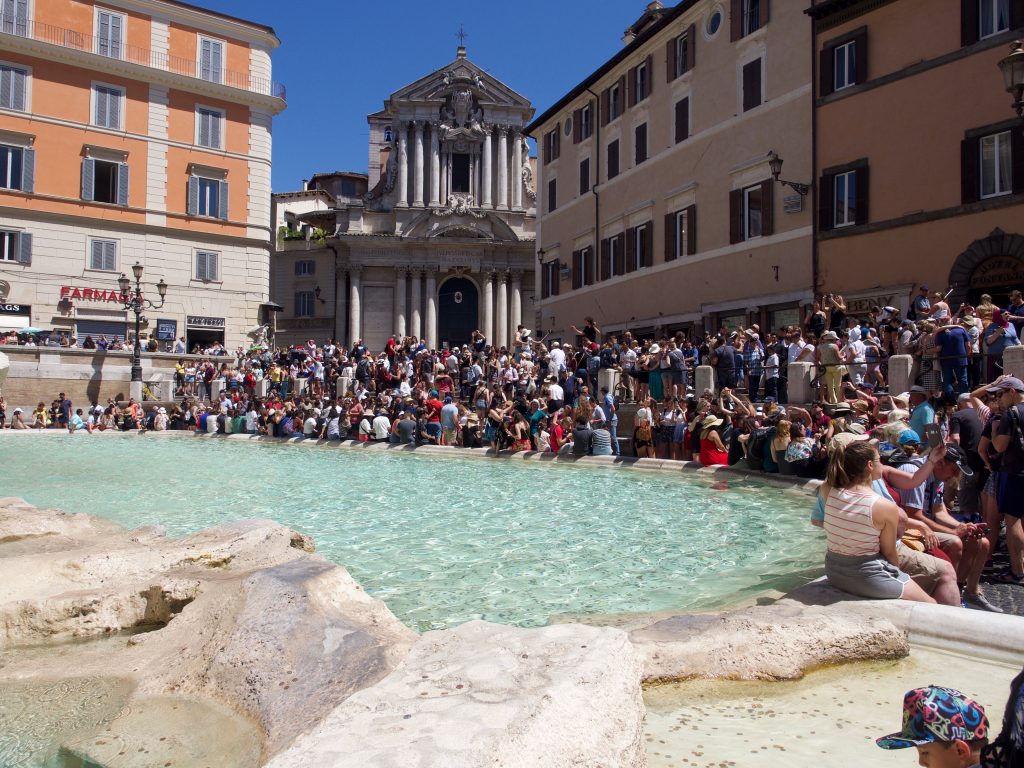
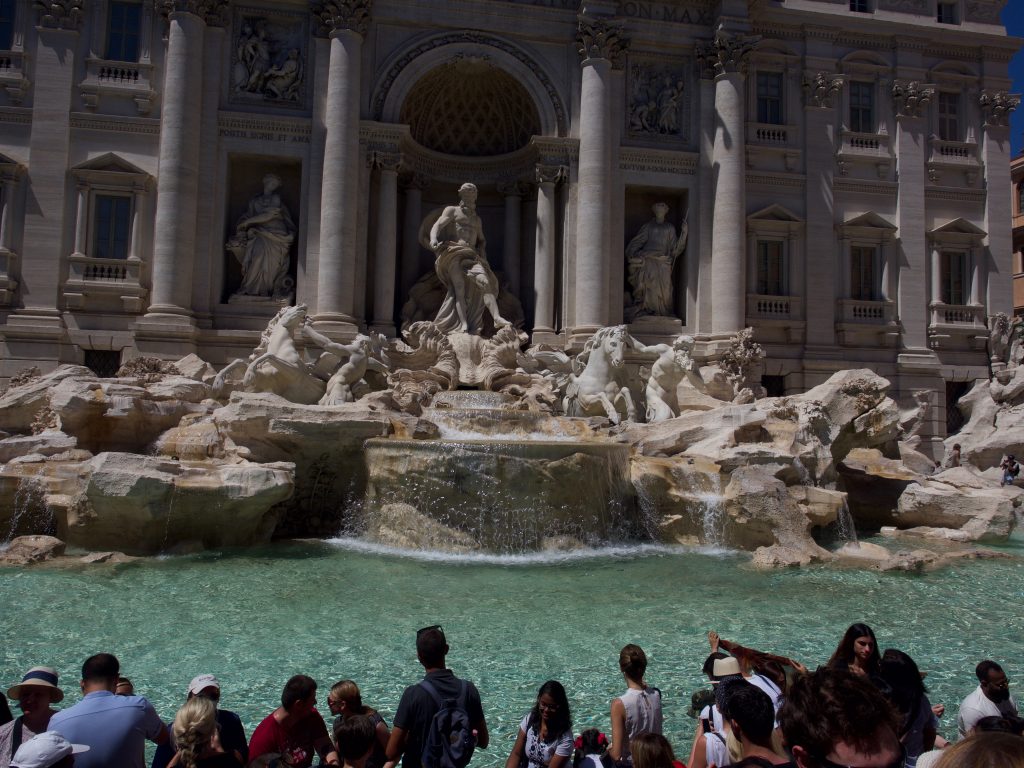
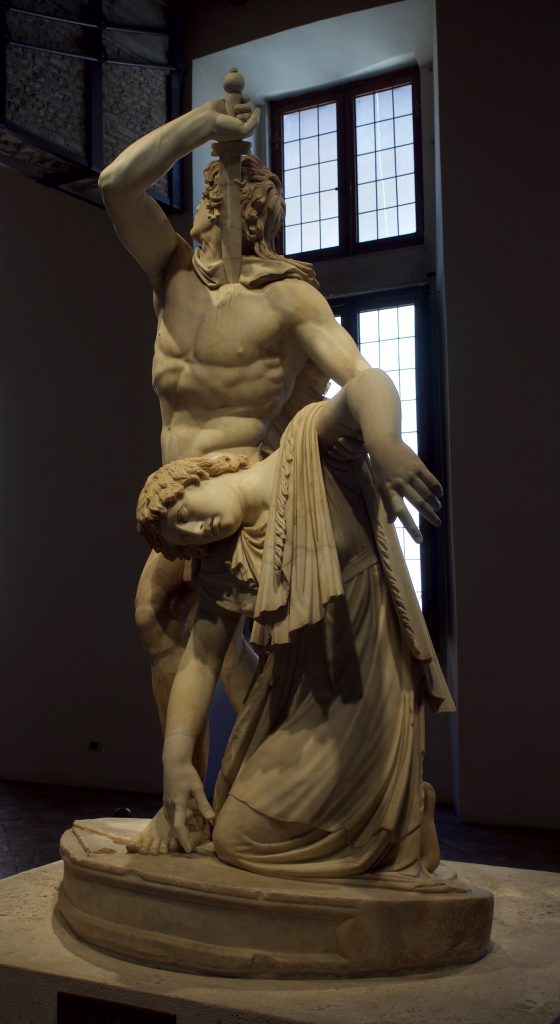
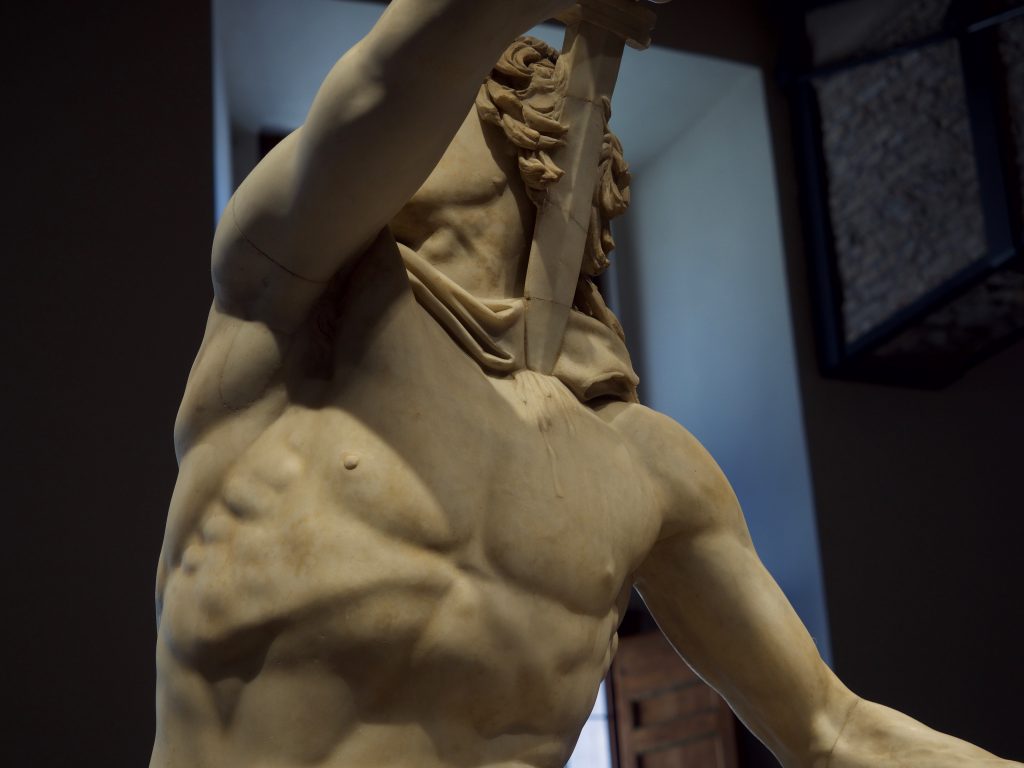
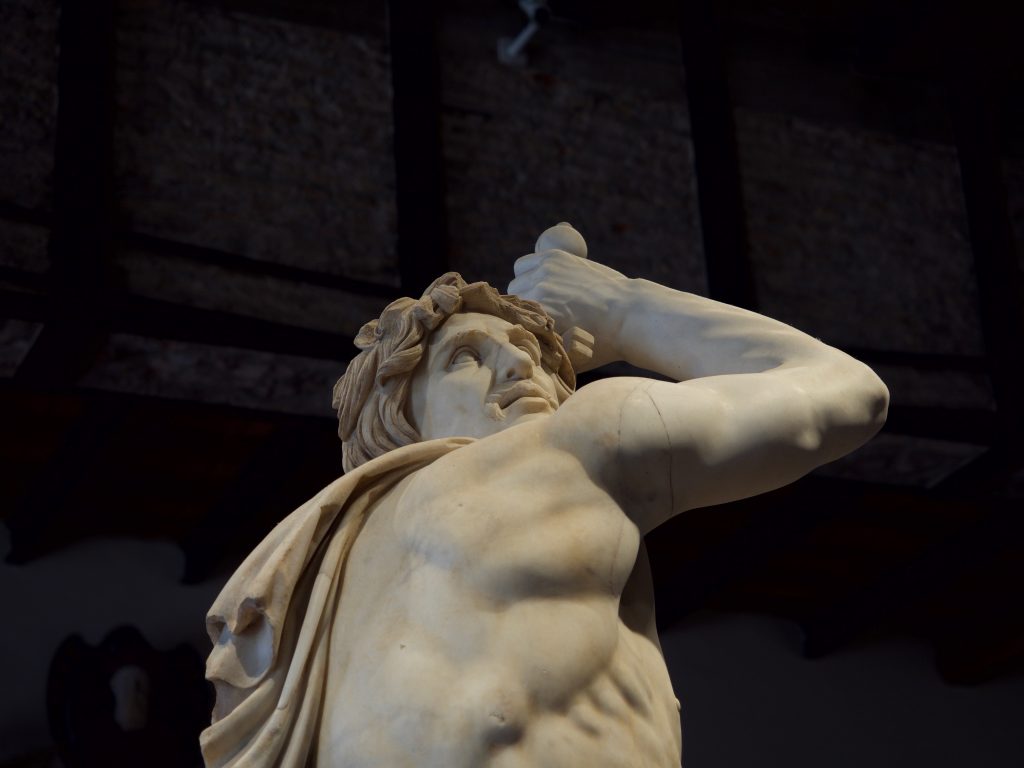
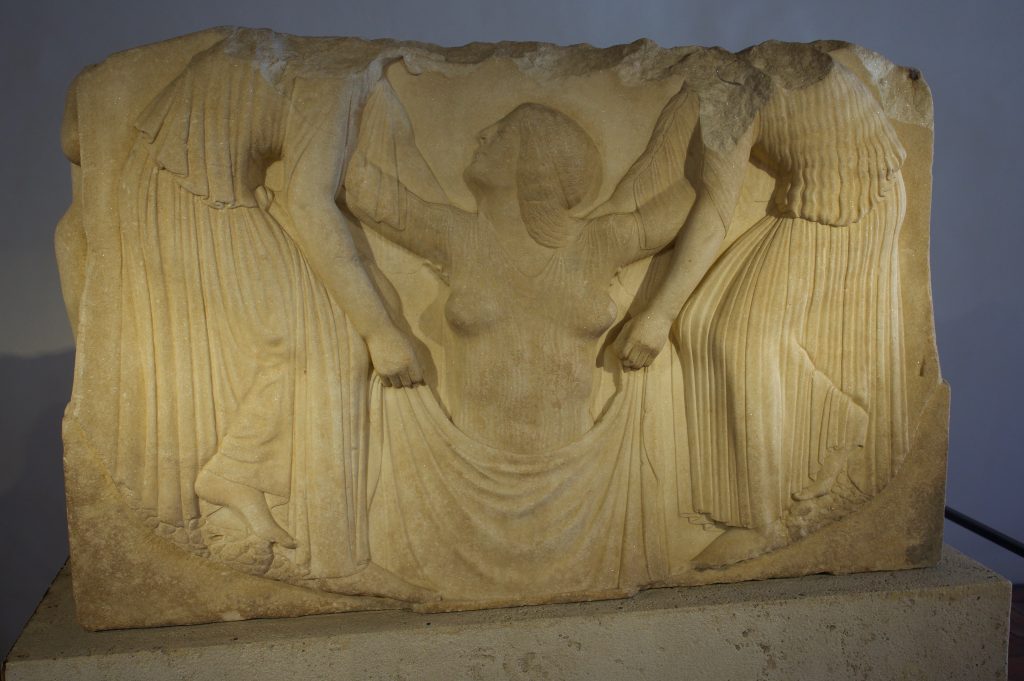
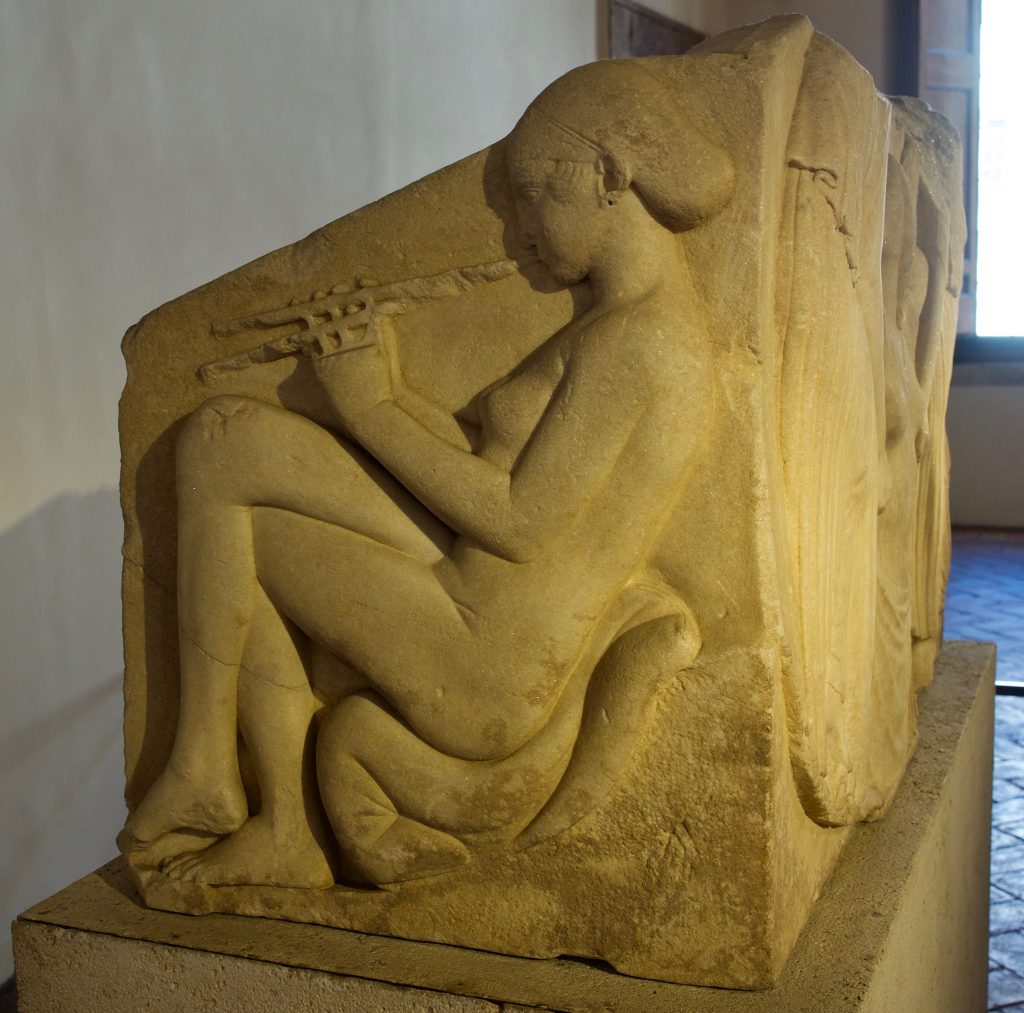
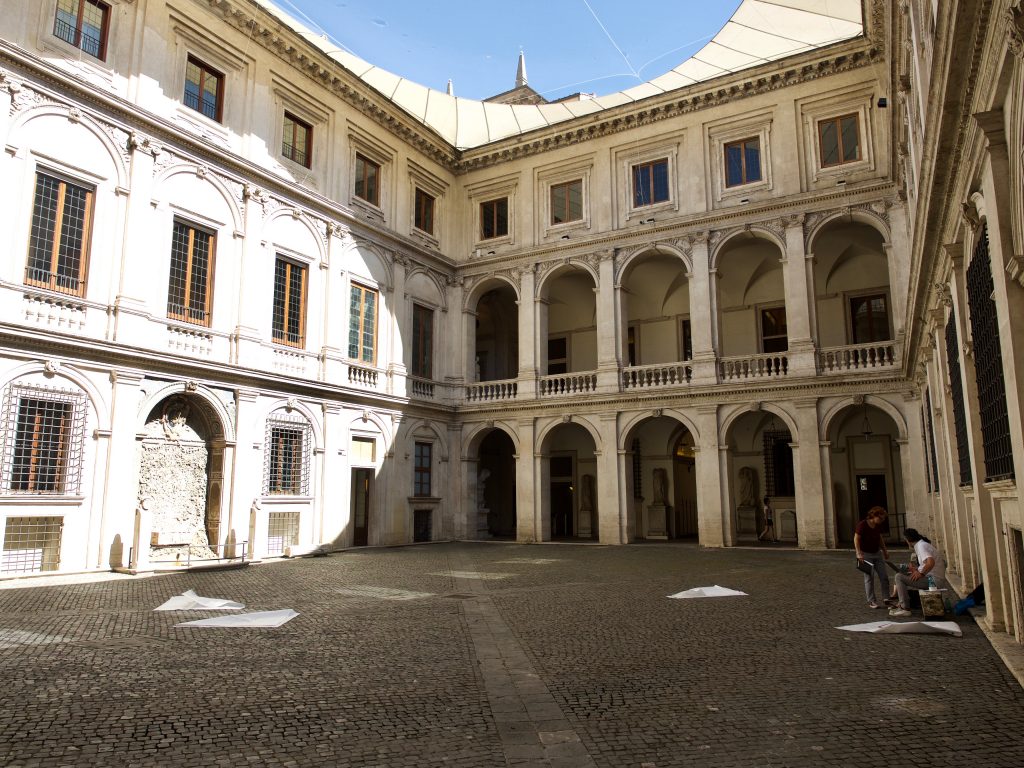
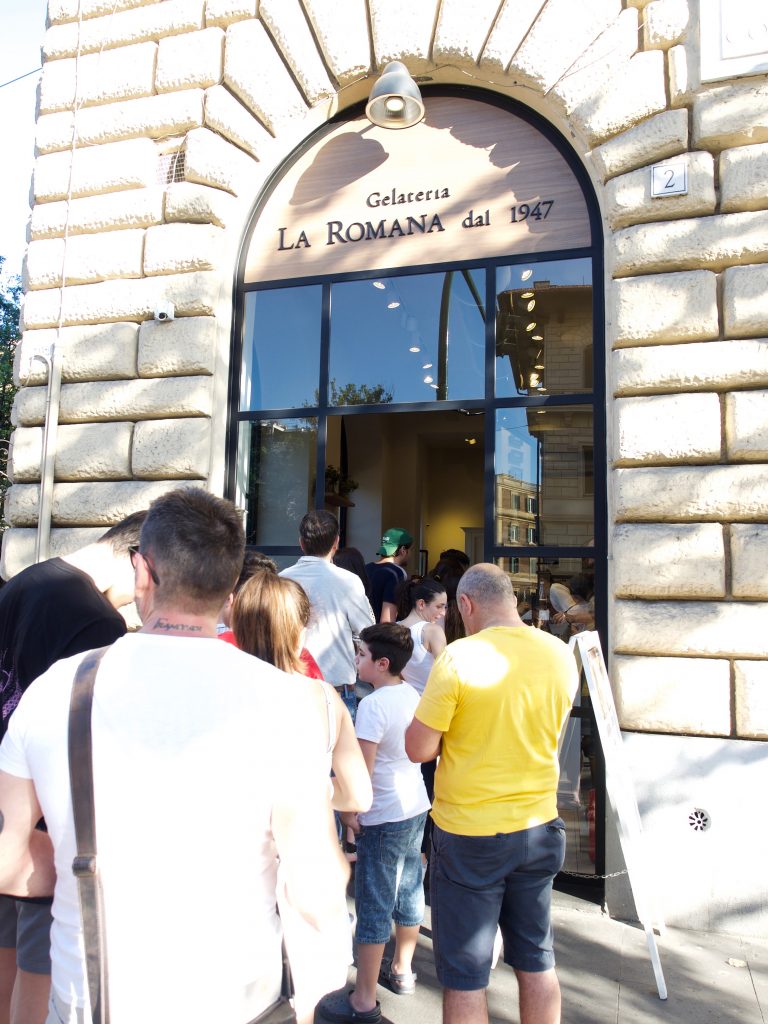
We took off after a quick breakfast (with the espresso machine operated for us by the woman who presided over the little buffet, just like yesterday) and, armed with a Roma Card for me (a present from Constance, who found it unused in her son‘s room) and a 24-hour public transport ticket for Mark, we set out for the day to explore a part of Ancient Rome I didn‘t manage to visit when I was here with my kids in 2010: the Via Appia Antica.
We started at the city gate San Sebastiano, which has a museum dedicated to the city walls in it. We found out about that on our way in Friday night, because our bus from the train station where the FlixBus took us went by substantial portion of the Aurelian Wall, which I had actually completely forgotten about. We were in awe but also curious about the remnants of this wall that was built between 271 and 275 centuries to protect the expanded city from various invading Barbarians, and still had major defensive purposes until 1870, when the military forces of the newly united Italy conquered Rome (and then made it their new capital, which up to then had been Florence). In doing superficial on-line research on the walls (originally 12 miles around, with towers every 100 Roman feet and 18 main gates, and with many miles of it still remaining all through Rome on the East side of the Tiber, as I learned from this amazing “walking tour of the Aurelian walls” webpage, http://heritagetimes.eu/aurelian-walls-part-1/ and http://heritagetimes.eu/aurelian-walls-part-2/), I had come across a reference to the Museo della Mure, the Wall Museum, in the former city gate. We checked it out; it was small, but it did not disappoint (also, it is completely free!)—we got to climb on one of the gate‘s towers, and also walk a little stretch along the inside of the wall, and there was a helpful model of the whole city with the city wall in place that gave us a sense of its extent and location. Beautifully half-ruined, but with so many posts and towers still in place, it is an impressive remnant of Roman architecture. In one of the little towers, we even saw a spot near the springing of the vault where herringbone brick patterns were used—something that we learned was really unusual and perhaps introduced by the occasional workers (who would have been slaves) who had learned their trade in Greece rather than in Rome. (There is a theory that Brunelleschi figured out the use of herringbone bricklaying like this from his study of the Roman ruins during his years in Rome, before his return to Florence and before submitting his cupola design.)
After our stop at the museum, we set out to walk toward the Via Appia Antica proper—of course, we were already on this very straight road going toward the south out of Rome, first conceived of and built in the 4th century BC, and a wonder of foresight and civil engineering. Today, it is a popular path for walking and especially biking that is basically part of Rome‘s Parks and Recreation operation, full of Roman ruins from all kinds of eras. Within it, though, are both a number of private residences and various museums, both owned by the city of Rome (some of them again free) and by private organizations. It‘s about 7 miles in total, and then the road goes on, of course, but it becomes a normal road again, while in the park, part of it still has the old Roman pavement (huge basalt flagstones, complete with thousands of years of ruts, and is lined, first with Roman buildings and then with Roman gravestones and memorial markers. It was hot and we had to contend with a lot of bicyclists, including some very inexperienced Americans who had obviously read in some sort of guidebook that renting a bike was the way to go, but it was so cool! We had gotten a really useful guide at the information station at the entrance to the park, and so we had basic explanations of the ruins we were seeing along the road, apart from open landscape with pine trees and cedars and meadows with poppies lined with stone walls.
Our first stop were the Catacombs of St. Callixtus, where the early Christians buried their dead underground in the 2nd to 5th century AD, digging little shelves and larger family vaults in the soft tufa that hardened as it was exposed to air, then burying their dead on these shelves or cubicles and closing up each with mortar and lime and adding a marble slab with an inscription. They can only be visited as part of a tour (they start on the half-hour in 5 languages), and we could only see the cubicles (technically called loculi) and family „rooms“ on the second level—while the 20 miles of labyrinthine walkways through the catacombs are actually on four levels. It was very interesting (no photography allowed) but the images from some of the wall paintings in the vaults that I had seen in my art history class were clearly from a part that we could not see or that had seriously decayed from the moisture of human breath—the guide said that up to 3,000 people a day come through to see this now. The two larger rooms that were used as chapels during the early Christian Era were the most interesting, with some frescoes and some marble slabs in situ, even though all the early popes once buried there had long been removed to various reliquary shrines all around Rome. The chapel of St. Cecilia had an copy of an arresting 1599/1600 Renaissance/Baroque sculpture from S. Cecilia in Trastevere (by one Stefano Maderno, whom I had not known, and who doesn’t seem to be related to Maderno the architect; the copy was dedicated on the slab beneath it to its sponsor, a woman named Edith McBride–and put there ca. 1920? This still strikes me as very odd and worth tracking down). The guide explained that this copy was sitting in place of where her body had been buried, allegedly disinterred intact and in exactly the pose Maderno depicted her in, in the 9th century. What I hadn’t realized is that the Catacombs were forgotten at some point in the early Middle Ages, and not “rediscovered” in their full size until 1854, even though they were the largest underground necropolis (or rather, rabbit warren for the dead) among the many in Rome (only some of which can be visited). The priest said that 500,000 people were buried in them, but I am assuming that this is the figure for all of Rome‘s catacombs, not just for St. Callixtus.
After this tour, we had a quick lunch in a garden cafe, where the waiter ignored us, but a sweet kid behind the counter made sure we got our food anyway, and gave us a little magnet with the colosseum as a souvenir. Then we continued along our way, actually finally hitting the Via Appia proper (the catacombs were on somewhat of a byroad). The pavement was really impressive (good solid Roman roads really last a long time!), if bumpy, and the most intriguing ruin complex was the the racetrack that was once part of the residential complex (call it palace, call it villa) built by the Emperor Maxentius. The two towers at the end, where the race began and ended, were still mostly there, as well as the walls along the track where I assume the spectators had their seat. The ruin of the villa itself was roped off and had a lot of scaffolding around it, so I assume that there are some structural problems. But the area was a huge hit with the Grand Tourists in the 18th century, who loved the picturesque ruins, and allegedly, one of the better-preserved rooms has a graffiti by the engraver Piranesi (or his son) who created incredibly popular engravings (the postcards of the 18th century) that we saw later in the day in the Museum Palazzo Altemps. I could see where Piranesi got his hallmark „overgrown ruins“ style of depicting the remains of Ancient Rome. There was also a fairly new excavation of a house and specifically its bath, with mosaics in situ (except where a sewer line from the 2nd century AD messed them up!), which showed the entire organization of the rooms and came with an explanation of the hot air/hot pipes heating system for the pools. I still think it is fabulous that the Romans used their power and wealth to develop long-distance fresh water access via aqueducts, reasonable sanitary sewers, and fabulous swimming pools with saunas and hot tubs. And awesome roads with pitstops everywhere, of course.
As we went along, we also saw a number of grave markers and other monuments, a notable one with a warrior honored by the classic „heroic nudity“ portrait, and one where someone had simply put all the fragments that were left of a monument rather randomly into a modern brick structure, something we also saw done on both older and newer buildings along the road before buildings petered out completely and we were basically in the countryside. Eventually, we turned around since without bikes, you really can‘t do the whole length of the Via Appia, especially not when it‘s 90 degrees and shade becomes a rarity. We walked back to a cross street with a bus stop, and then took the bus and metro back to the downtown area. Mark had expressed a wish to see the Trevi Fountain (we HAD watched Roman Holiday shortly before we left, after all), and it was of course completely packed with tourists, plus so gleamingly white after the recent renovation and clean-up that it was difficult to photograph. But we can now say we‘ve seen it… we didn‘t have any small coins, but I stuck my hand in the water. Does that count?
Equally crowded on the way home were the Spanish steps and piazza by the Pantheon, but then we ducked into side streets and went inside the cool and quiet of our last museum, the Palazzo Altemps, which like the Palazzo Massimo, is dedicated to „second-tier“ antiquities that have nothing second-tier about them. We were admittedly pretty tired by then, and the many, many portrait busts (not my interest at all) got none of our attention. But there were several beautiful Aphrodites of various types (my favorite remains the Crouching Aphrodite; we collected several more), and a couple of Greek original works, the most important of which is the Ludovisi Throne—a 5th century BC U-shaped section of a Greek altar that is thought to represent the „birth“ of Aphrodite, as she is pulled out of the sea by two helpers, clad only in a diaphanous gown, on the front, and on the side pieces two helpers, one of them the first fully naked woman in Greek sculpture. I was very excited to see this piece, even more so than to see the Ludovisi Gaul, the „second dying Gaul,“ second to his more famous relative, the Dying Gaul, in the Capitoline Museum, which I saw in 2010 —a unique and almost complete Roman copy of a Hellenistic representation of a Gaul committing suicide by sword as he is holding his already dead wife. Very dramatic and compositionally amazing, but naked women trump guys stabbing themselves with swords (even naked ones) anytime, as far as I am concerned.
Beyond the additional art we saw here (mostly sculpture, but there were also the rare old prints from the 17th and 18th century of the ruins of Rome as they looked then, and some other miscellaneous collections we no longer had the brains to retain), the building itself was super cool. I have to research the history of the palazzo a bit more, but it was clearly a Renaissance palace that was also sitting on top of Roman ruinsm first built in the 15th century and then upgraded several times, including by Martino Longhi in the mid-1500s. The freshly-renovated building, with partly uncovered / excavated foundations but also a Renaissance chapel, a beautifully restored courtyard and a loggia with amazing ceiling paintings that used to hold the „twelve Caesars“ Roman portraits (and now holds some of them again). Apparently, it only became a museum in 1997, which explains the extraordinary combination of good curation and lovingly restored but decidedly “background” palazzo ambiente. A greater contrast to, say, the Palazzo Pitti, can’t really be imagined.
I made two more stops on the way home with the almighty power of my Roma Card, while Mark waited outside (that’s how cheap we were). First, I went to see the Ara Pacis Augustae (which would normally cost an exorbitant sum), which is inside a very white and gleaming modern box of a museum, a sort of reliquary shrine for the giant walk-in altar (aka propaganda piece for Augustus and his family).
Second, I stopped at the Goethe House (even though that was another discounted ticket), where Goethe lived with his friend, the painter Tischbein (of the famous „Goethe in the Campagna“ portrait), when he was on his Italian tour in the late 18th century. There wasn‘t much to the permanent exhibit (no furniture etc. remained from those rented rooms), but I was usefully reminded of Goethe‘s friendship with Angelica Kauffman, who also painted a couple of portraits of him, and of the watercolor painting by Tischbein called „Goethe am Fenster,“ which is set at one of the windows in the apartment. The special exhibit was about the afterlife of the Sorrows of Young Werther, Goethe‘s perhaps most internationally famous book, something I knew a lot about already, too—but with some pictorial evidence that I didn‘t know anything about (genre scenes based on scenes from the novel, Goethe in Werther gear, and genre scenes of people reading Werther in large, rapt groups al fresco). There was also a silkscreen print of Andy Warhol‘s Goethe based on the famous Tischbein painting. Goethe‘s Italian journey (both his actual trip and the book he wrote about it) are really crucial for his development as a writer, especially as he changed and deepened his ideas about the Greeks and the Romans and shifted away from a more exclusive interest in German and „Germanic“ history, legend, and culture to a broader view of Western heritage that was influenced by precisely the people I‘ve been reading and thinking about—Winckelmann, for example, and the earlier Renaissance scholars who began to dissipate and expand on the knowledge that had been fully or at least half-buried for centuries. Of course, the story of the Renaissance and of the relationship of late 18th century neoclassicism to that Renaissance is way more complicated than that, but there is something about its simplified form that still makes good sense to me. Given that I really like Goethe‘s writings (and went to Weimar with Mark last year WITHOUT checking on all his art / art-history connections!), and continue to be interested in cross-cultural connections, not to mention that George Eliot and George Henry Lewes were really into Goethe and his neoclassicism, there may be work on this in my future… at any rate, the synapses were crackling, even though the visit to the museum was at most 10 minutes long.
At this point, we were truly spent—I suspect that of the 13 miles of steps that my phone logged, at least 10 happened on the via Appia Antica. We walked toward our hotel, and although we made an honest effort to find another restaurant, we ended up eating something new at the same place we‘ve been the past two nights—I had a salad with fresh mozzarella in it (they use a lot of arugula here, which I love) and Mark had the carbonara pasta, and we had what they called focaccia, which was basically a fresh-baked pizza with nothing except some olive oil, sea-salt, and rosemary, fresh out of the oven. Delicious. But we left enough room to treat ourselves to a medium-size gelato at the fabulous gelateria on the same block (where there is always a long line, and for good reason!). So I had three flavors, and their fantastic zabaione-flavored whipped cream on top. Mark had his usual dark chocolate and amarena cherry, but it was all out of this world. I may forget my facts about Ancient Rome, but this gelato was unforgettable.
The last activity of the day was that we walked to exactly where the airport bus stop is, to time how long it would take us to get there early the next morning. Then we finally went back to our spiffy, clean, and air-conditioned hotel room, around 7:30 pm, sifted through photos, journaled, and packed as much as we already could. It was nice to have an early night, and taking a shower at the end of a hot and sticky day was glorious. I cannot believe that we had 14 days of uninterrupted summer weather, with not a drop of rain and no more than occasionally partly cloudy skies. Everything was in bloom, and even though we got hot and sweaty some of the time, it was just fabulous to have such absolutely beautiful vacation weather the entire time we were in Italy!